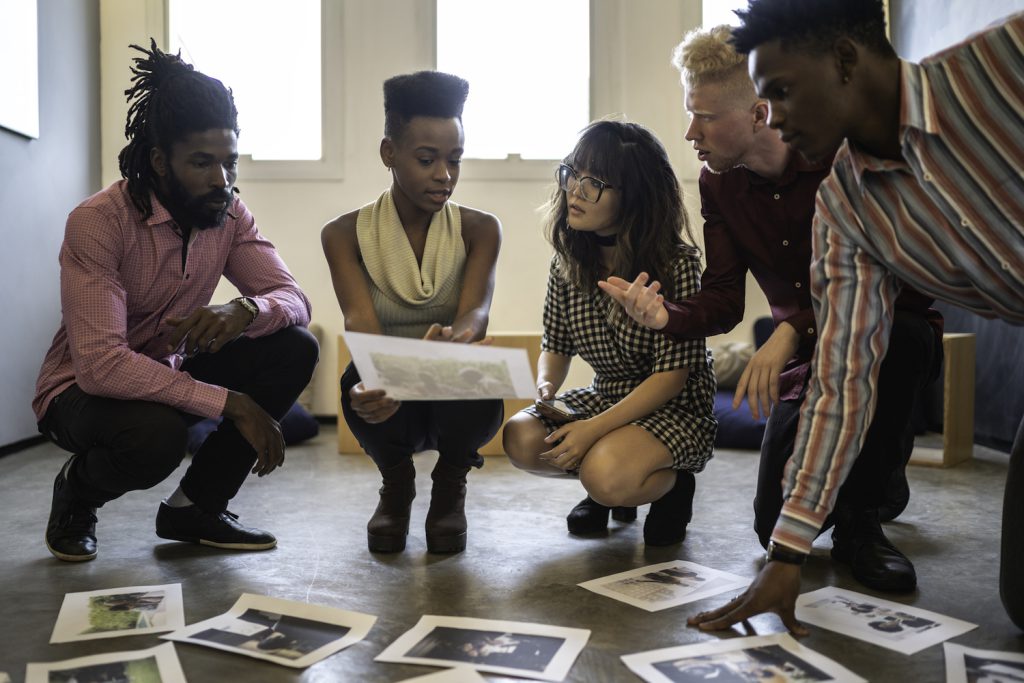The Power of Images

Ask SAPIENS is a series that offers a glimpse into the magazine’s inner workings.
The headlines and powerful prose of the anthropologists and journalists who write for SAPIENS draw our readers in time and again. But, as the art coordinator for the magazine, I also like to think that the images play an important role in the recounting of anthropological adventures.
In my position at SAPIENS, I select the art that accompanies the written pieces featured in the magazine. While I do have days that consist of perusing through beautiful pictures of sunsets, often the task of selecting art for our pieces is more complex than one might think. Images convey the ideas authors put forth in words. The task of finding the right image to perplex, awe, and amuse our readers requires reflection, teamwork, creativity, critique, and compassion.
While similar art coordinator positions exist at newspapers and journals, as an anthropologist working for an anthropology magazine, I face certain challenges that many of my counterparts do not. To explain, I’ll walk through my process: how I systematically approach each piece, how I grapple with sticky ethical issues, and how I make my final picture selections.
Whenever I receive a new piece from the editorial team, I first read the text and figure out where to place the images and highlighted excerpts, or pull quotes. While I read, I identify the core idea, action, or concept that is the crux of the writer’s story, then consider how to convey that in the header, the leading image that appears at the top of the piece.
For the body of the article, I hunt for pictures that either offer readers a snapshot of an anthropologist’s field site or help illustrate other key ideas in the text. I try to support the writer—to tell the same story they’re telling but through images.
At times, when in need of some creative intervention, I hire illustrators. When I think readers would benefit from a bird’s-eye view of a particular corner of the world, I look for maps online or, in special cases, call on a cartographer.
But in most cases, I search for photographic images available for free use through Creative Commons licensing. I also secure permission to publish images from private collections, our authors’ fieldwork photo albums, and from paid professional repositories, such as Getty Images and Associated Press Images.
When searching through photos, I follow rules that have been set by the editorial team. For instance, I do not include images of human remains unless absolutely necessary.
I start with composition. I look for photographs that are aesthetically pleasing and interesting—those that use light, filters, focus, and angles to uniquely portray an idea or subject. I also seek out images that accurately represent the author’s writing and the experiences they describe.
Be sure to check out our free, self-guided SAPIENS Public Writing Training.
On any given day, I might spend hours gaining access to images of teeth or searching for a suitable photo of baseball players or Ecuadorian figurines. (One day, while looking for images of Baby Yoda, I was able to calm my frazzled nerves by looking at pictures of hundreds of adorable infants.)
During this process, I interact with other members of the production team at SAPIENS. I ask the editorial staff to weigh in on images and illustrations, and work through concerns the author might have with my initial selection. I find it invaluable to have other perspectives, especially when approaching imagery from an anthropological point of view.
That’s where the sticky ethical issues start.
Anthropology has a legacy of creating and sustaining harmful beliefs. The discipline helped establish and support scientific racism, a set of pseudoscientific beliefs about race and racial hierarchies that justified the atrocities of 18th- to 20th-century colonialism, slavery, and genocide. These histories continue to have an impact today, forming the basis for socioeconomic and political inequality around the globe.
Representation plays a crucial role in maintaining injustice. Colonial and imperial powers—aided by anthropological contributions—denied colonized and enslaved peoples the right to control their own stories and images, instead promoting stereotypical caricatures and other visual representations that further misrepresented and degraded these populations.
For that reason, I want to use pictures that show our species—and the diversity of human experiences—in ways that challenge inequality, discrimination, and harm.
For instance, I consider issues of consent during photo selection. For images without a Creative Commons license, I require permission to publish from the person who owns the rights to the photo and confirmation that they received consent from the people pictured. I also check for discrepancies with the text. For instance, if a person’s identity has been protected with a pseudonym in the piece, their image should probably not be included either.
I also reflect on what images convey to the public. For a feature about Mongolian milk microbes, for instance, I received a series of images from a researcher featured in the piece. One showed a group of Euro-American archaeologists making a presentation to Mongolian community members. The image was taken from the back of the room, so only the backs of community members’ heads and the faces of the standing archaeology team were visible. This particular image could have made it seem as though White, Western archaeologists were teaching Mongolians about themselves, which was not at all what the author wanted to convey.
I opted instead for a picture that showed members of both groups standing side by side, conveying a horizontal knowledge exchange: The scientists are demonstrating dairy microbiology, and community members are sharing generational knowledge about dairy production.
That image shows readers a different kind of power dynamic than what they might be used to. It highlights current shifts in anthropological ethics, research methods, teaching, and writing—all aimed at decolonizing the discipline.
In a similar manner, when looking for images for the Ask SAPIENS pieces “Why Capitalize ‘Indigenous’?” and “Why Capitalizing ‘Black’ Matters,” I made sure to depict Indigenous and Black people in ways that did not perpetuate tired tropes. Both header images show intergenerational communities, which conveys a sense of collective identity and an awareness of shared histories and futures.
I grapple with questions of representation even when looking through photo repositories. Stock images dictate the kinds of portrayals we see, use, and share, and they are not always diverse or free of problematic messaging.
These concerns are also relevant to the illustrations we commission. I always ask other team members to weigh in because I want to make sure we are asking ourselves what biases might shine through.
For example, in the first draft of an illustration that accompanied a piece about anthropological poetry, the artist depicted a lighter-skinned person observing a darker-skinned person while writing in a journal. We found ourselves asking: “Why does the onlooker have lighter skin? Are we perpetuating the idea that all anthropologists are White? What message does that send?” We ended up asking the illustrator to adjust the drawing so that both the observer and the observed had darker skin.
But even with these careful considerations, I don’t always get it right.
My expertise as a cultural anthropologist has afforded me the opportunity to learn a great deal about my area of study. But anthropology—the study of humans—remains a vast field, and I encounter unfamiliar subject matter every day.
Luckily, through working at an anthropology magazine, I interact with and learn from talented anthropologists who are experts in their fields of study. At times, some of these professionals, or other readers, write to let us know about problems they notice.
In one recent case, for a journalist’s feature about milk sharing, I decided to include a historic drawing of an enslaved Black woman breastfeeding a White infant. This image of a wet nurse portrayed a painful and exploitative history, but the editorial team and I felt it merited inclusion so our readers could face this part of the past.
After publication, an anthropologist featured in the piece reached out and asked that we replace the image. She explained that such images do harm; some Black mothers choose not to breastfeed their children because of the association with wet nursing. The team and I decided to change the picture to a contemporary photo of a Black woman breastfeeding a Black child and included an Editors’ Note describing the original image and why we replaced it.
When selecting images, I always aim to demonstrate the diversity of our species. If an article focuses on ancient buildings, I include places that are often left out of discussions. When covering universal human experiences, like infancy, pregnancy, and aging, I work to ensure those experiences are depicted in as many variations as possible.
I am looking for the sweet spot: a visually captivating image that offers an accurate portrayal of the author’s story and reflects ongoing debates over why representation matters.
As a species, humans are dynamic, brilliant, alarming, and contradictory, much like the relationships we have with other people, animals, systems, ideas, and environments. My job, ultimately, is to portray our wonderfully complex humanity as authentically as I can.































